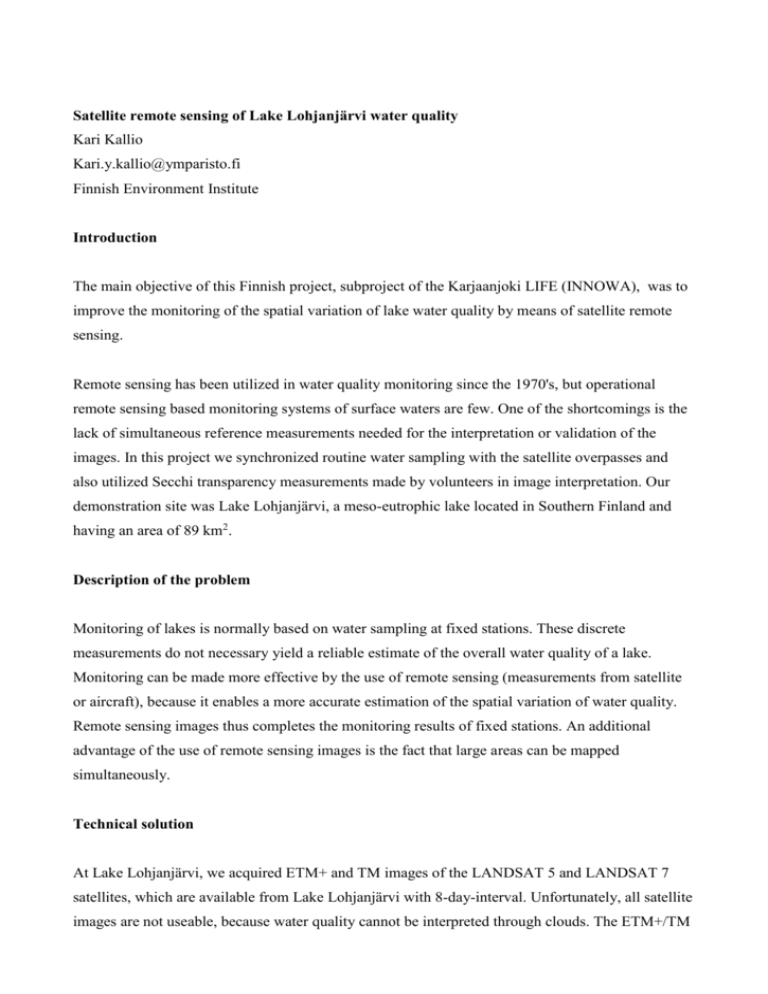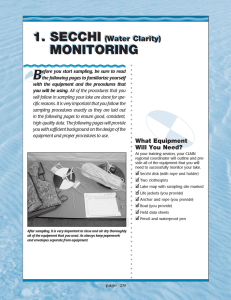Satellite remote sensing of Lake Lohjanjärvi water quality
advertisement

Satellite remote sensing of Lake Lohjanjärvi water quality Kari Kallio Kari.y.kallio@ymparisto.fi Finnish Environment Institute Introduction The main objective of this Finnish project, subproject of the Karjaanjoki LIFE (INNOWA), was to improve the monitoring of the spatial variation of lake water quality by means of satellite remote sensing. Remote sensing has been utilized in water quality monitoring since the 1970's, but operational remote sensing based monitoring systems of surface waters are few. One of the shortcomings is the lack of simultaneous reference measurements needed for the interpretation or validation of the images. In this project we synchronized routine water sampling with the satellite overpasses and also utilized Secchi transparency measurements made by volunteers in image interpretation. Our demonstration site was Lake Lohjanjärvi, a meso-eutrophic lake located in Southern Finland and having an area of 89 km2. Description of the problem Monitoring of lakes is normally based on water sampling at fixed stations. These discrete measurements do not necessary yield a reliable estimate of the overall water quality of a lake. Monitoring can be made more effective by the use of remote sensing (measurements from satellite or aircraft), because it enables a more accurate estimation of the spatial variation of water quality. Remote sensing images thus completes the monitoring results of fixed stations. An additional advantage of the use of remote sensing images is the fact that large areas can be mapped simultaneously. Technical solution At Lake Lohjanjärvi, we acquired ETM+ and TM images of the LANDSAT 5 and LANDSAT 7 satellites, which are available from Lake Lohjanjärvi with 8-day-interval. Unfortunately, all satellite images are not useable, because water quality cannot be interpreted through clouds. The ETM+/TM images have a good spatial resolution (30 m x 30 m) and include over 100 000 pixels from Lake Lohjanjärvi. For all these pixels the estimation of turbidity, concentrations of total suspended solids and Secchi transparency was made. All the water quality measurements and volunteer observations were synchronized with three satellite overpasses in May–September in 2002-2004. In addition, backup days were available, if the pre-planned days were cloudy. The acquired cloudless ETM+/TM-images were from 25th May 2002, 9th Sept. 2002, 17th May 2004 and 5th Aug. 2004. After the rectification and georeferencing of the images, the interpretation algorithms were formulated using the conventional water quality measurements at ten monitoring stations and Secchi transparencies measured by volunteers, which were available from 20 locations at best. The interpretation algorithms were constructed by comparing the satellite measurements at different channels with the field observations. Water quality maps were made by applying these algorithms to every water pixel in the image. Turbidity depends on the concentration of suspended solids in the water and its interpretation is based on the fact that turbidity increases reflectance from the water. At Lake Lohjanjärvi, Secchi transparency is mainly explained by turbidity and therefore, it can also be interpreted from the ETM+/TM images. According to the interpreted ETM+ and TM images regional differences of Secchi transparency in Lake Lohjanjärvi are pretty much the same during the ice-free period: lowest Secchi transparencies are in the same regions, although values in spring are lower than in summer. The lowest Secchi transparencies were in the eastern part of the lake were water quality is influenced among others by diffuse loading via the Hossa inlet in the north-east (Fig. 1). Also in the southern parts Secchi transparency was lower than in the central parts of the lake. In general, water gets clearer from east to west. Outamonjärvi, the sheltered bay in the north, was the clearest part of the lake both in spring and in summer. The comparison of the turbidity maps indicated that turbidity in spring can be 2-3 fold when compared to the situation in late summer (Fig. 2). The summer of 2004 was an exception, because heavy flooding increased turbidity in the eastern part of the lake to the same level as in spring as indicated by the TM image of 5th Aug. 2004 Results and impact Remote sensing is an effective tool in lakes where spatial variation of water quality is high. The same method can be applied for the mapping the lakes over large areas, because one ETM+/TM image covers an area of 150 km x 150 km. The airborne remote sensing measurements carried out at Lake Lohjanjärvi indicate, that in addition to turbidity, total suspended solids and Secchi transparency also trophic level (chlorophyll a) and humic substances can be estimated by remote sensing. However, the estimation of chlorophyll a is not yet possible with operational satellite instruments with high spatial resolution due to lack of the instrument characteristics (e.g. channel configuration). For the best result, conventional monitoring of lakes (water sampling) should be synchronized with the satellite overpasses. With the aid of satellite images the monitoring results measured at fixed stations can then be spread to wide areas within a lake and in a group of lakes. The volunteer Secchi transparency measurements were here utilized for image interpretation to our knowledge for the first time in Europe. This experiment was successful and with the aid of volunteer observations more reliable interpretation of the images could be made than by just using the field measurements of the routine monitoring. Fig. 1. Secchi transparency of Lake Lohjanjärvi and surrounding lakes on 20th May 2002 based on the LANDSAT ETM+-image. Interpretation of the image was based on the Secchi transparency measurements made by volunteers at 19 locations. Original image: © EDC DAAC, 2002, Eurimage/Novosat Oy. Fig. 2. Relative frequency of turbidity in Lake Lohjanjärvi on 20th May 2002 and 9 h Sept. 2002 estimated from the LANDSAT 7 ETM+ images. The total number of ETM+ pixels in Lake Lohjanjärvi is over 100 000.










